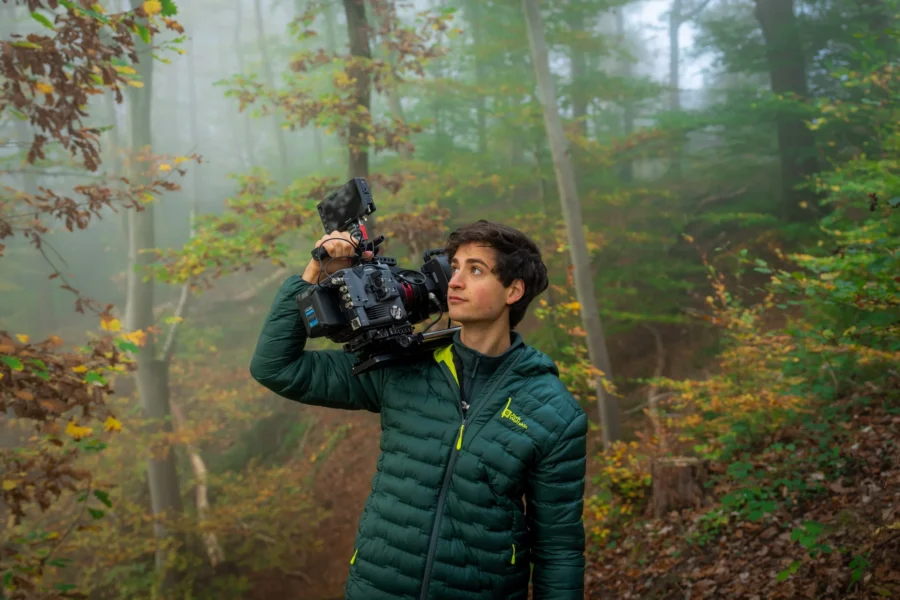Gamander López has risen to become a compelling figure in contemporary visual arts, transcending the conventional boundaries of nature photography and documentary filmmaking. His practice resonates deeply within the broader cultural discourse for its openness, particularly concerning environmental awareness and the evolving role of digital media in art dissemination. He positions himself as an interpreter of its inherent beauty of the wild and its fragility. His work fuses a profound curiosity with an innate artistic sensibility, creating a unique dialogue between observation and expression. His self-description as a wildlife filmmaker and photographer from Germany, deeply fascinated with all animals, underscores a core artistic intent: to capture the beauty he perceives in them and inspire others to protect it. This aspiration to inspire protection, rather than merely document, elevates his work beyond simple aesthetic appreciation, situating him as an artist whose vision actively contributes to the environmental art movement. The impending pursuit of a biology degree further deepens the interdisciplinary nature of his practice, suggesting a continuous quest for knowledge that enriches his artistic output by providing a more informed understanding of the subjects he portrays.

The Genesis of a Gaze, Biography and Early Development
Born in Aachen, Germany, in 2002, Gamander López embarked on his artistic journey with an unusual precocity. His mother fostered an early passion for nature through long outdoor walks, an initial inspiration that proved foundational. At the tender age of ten, he received his first camera, a pivotal moment that immediately channeled his fascination into photographic and cinematic expression. This early engagement quickly evolved beyond simple captures into the creation of “little documentaries” about the animals he encountered. This self-driven, continuous learning about animal species and their behavior has defined his formative years and professional trajectory.
The timeline of López’s early achievements reveals a prodigious talent. He began winning significant national and international film festival awards as early as 2016, when he would have been approximately 14 years old. This indicates not merely an early start, but a remarkable, sustained level of achievement from a very young age. It suggests a deep, almost instinctual connection to his subject matter and craft, distinguishing him as an artist whose innate abilities were recognized and cultivated early, leading to a rapid ascent in his field. This is not the narrative of a late-blooming artist, but rather of a natural aptitude that quickly found its medium.
The seamless integration of personal passion and professional calling has been a defining characteristic of López’s life. His early fascination with nature, coupled with the immediate acquisition of a camera, suggests that his life’s path was set early and consistently pursued, rather than being a later career shift. His declaration that he has “never stopped learning everything possible about animal species, their behaviour and how to capture it best” underscores a holistic development where his vocation emerged organically from his deepest interests. This profound dedication underpins the authenticity and depth of his work, lending it a resonance that extends beyond mere technical proficiency.

Technological Mastery and Artistic Evolution
López’s artistic development is inextricably linked to his embrace of advanced photographic and cinematic technology. His journey began with early struggles using third-party lenses on a Sony Alpha 7 III, particularly with autofocus, a critical function in dynamic wildlife scenarios. A decisive turning point arrived with the adoption of Sony’s G Master lenses and the Alpha 1 camera, which dramatically improved his ability to capture sharp, precise images of fast-moving subjects, even small birds in flight. His technical acumen extends to a deep appreciation for the ergonomics and specific features of his equipment, such as the internal zoom of the 70-200mm f/2.8 G Master II lens, which facilitates rapid adjustments and stable video work. He was also an early tester of the Alpha 7R V, praising its AI-powered autofocus and high-resolution sensor, recognizing these as crucial for capturing fleeting moments with unparalleled detail. This command over cutting-edge tools allows him to translate his keen observations into visually stunning and technically flawless compositions. Beyond still photography, López has evolved into a skilled documentary filmmaker, working as a camera operator for natural history films, including productions for Oliver Goetzl in Finland, capturing species like Siberian flying squirrels, brown bears, and wolverines. This dual mastery of still and moving image technologies underscores the breadth of his artistic and professional capabilities.
While López extensively details his reliance on advanced Sony cameras and lenses, he consistently frames these tools as facilitators for capturing “unique moments” and “the beauty I see”. He emphasizes how the technology allows him to “concentrate on framing the composition and observing the animals’ behaviour,” rather than being distracted by technical limitations. This suggests that his artistic vision drives his technological choices, and the technology serves to remove barriers to realizing that vision, allowing for an unburdened focus on the ephemeral beauty of the wild. It underscores that his art is not about the gear, but rather created through it, highlighting a symbiotic relationship where technology empowers artistic expression.
The necessity of patience and preparedness in his high-stakes environment is a recurring theme in López’s commentary. He frequently mentions the requirement of waiting “many hours for an animal to appear” and then having “only one opportunity to press the shutter release”. His reliance on highly responsive autofocus systems and lightweight gear is a direct consequence of this high-pressure, split-second reality of wildlife capture. This reveals that his technical mastery is not simply about producing sharp images, but about ensuring readiness and reliability in unpredictable natural environments. The art emerges from a blend of profound patience and instantaneous, decisive action, all enabled by trusted technology. This fusion of meticulous planning and spontaneous capture defines a significant aspect of his creative process.

Aesthetics of Intimacy: Mediums, Visual Language, and Conceptual Frameworks
López’s visual language is characterized by an aesthetic of intimacy, drawing viewers into the private worlds of his subjects. He primarily works in still photography and documentary filmmaking, capturing wildlife in their natural habitats with a keen eye for detail and emotion. His compositions often feature close-up perspectives, allowing for a deep connection with the animals, whether a “little mouse or a big bear”. The prevailing visual aesthetic on his platforms emphasizes high-quality animal photography and videography with a focus on “cute” and “sleepy” animals, often set against natural backdrops of forests, snow, or serene landscapes. He expertly utilizes natural light, from “beautiful sunrise” to “dreamy” foggy atmospheres, to evoke specific moods and enhance the emotional resonance of his imagery. His technical choices, such as precise autofocus and high-resolution sensors, contribute to the crisp, detailed quality of his work, ensuring that every feather or fur strand is rendered with clarity. Conceptually, López is driven by a desire to “capture the beauty I see in them” and to seek “special encounters” and “magical moments” in nature. This pursuit of profound, often fleeting, connections with wild animals forms the core of his artistic philosophy. His work is not merely observational; it is an act of reverence, seeking to convey the inherent wonder and dignity of each creature.
The concept of the “magical moment” serves as a conceptual keystone in López’s artistic philosophy. He repeatedly refers to “that magical moment when the animal I have been waiting for suddenly appears in front of my lens”. This is more than a mere description of an event; it functions as a conceptual framework for his entire body of work. The “magic” implies an almost spiritual connection, a transcendence of the purely observational. It suggests that his art is an attempt to capture and share this profound, almost mystical, experience of communion with nature, making the ephemeral encounter tangible and universal for the viewer. This elevates his work from simple documentation to a form of experiential art, inviting the audience into a shared moment of wonder.
A compelling paradox defines López’s approach: the achievement of profound intimacy in the wild. His close-up shots and focus on endearing animals create a palpable sense of closeness. Yet, these are wild creatures, often filmed from a distance with long lenses, maintaining a respectful boundary. The paradox lies in achieving this deep intimacy without intrusion, respecting the inherent wildness of the subjects while simultaneously revealing their tender or vulnerable aspects. This approach speaks to a sophisticated understanding of animal behavior, likely informed by his ongoing biology studies, and the ethical use of technology to bridge the physical distance. He manages to create a connection that feels deeply personal without being invasive, inviting empathy without anthropomorphizing, a delicate and masterful balance.

Narratives of the Near and Far, Key Works and Their Resonance
López’s artistic output extends beyond individual photographs to cohesive narrative works, particularly in filmmaking and publishing. His short films have garnered significant acclaim, screened at national and international festivals and earned numerous awards. “The Wood Behind The Trees,” a 2019 film, won the “Deutscher Jugendfilmpreis” and “Bester Kurzfilm für Kids” at the Greenscreen Festival. This film explores the hidden life within seemingly ordinary forests, aiming to reveal the richness that exists “between these trees” and inspire its preservation. Another notable work, “Wo die Natur aufhört” (2020), nominated for “Bester Kurzfilm für Kids” at the Greenscreen Festival, challenges perceptions by showcasing wildlife observed directly “at home,” prompting viewers to recognize nature’s presence in their immediate surroundings. These films demonstrate his commitment to visual storytelling that not only entertains but educates and advocates for local conservation. In September 2024, López expanded his narrative reach with the release of his first book, “Moments in Nature,” co-authored with his sister Una López. This German-language book focuses on wild animals found “right at your doorstep,” blending personal anecdotes with scientific information and practical tips for observation and photography. The book serves as a tangible extension of his artistic philosophy, making his vision accessible to a broader audience and encouraging direct engagement with nature.
A distinctive aspect of López’s work is its focus on localized conservation through universal themes. Films like “The Wood Behind The Trees” and “Wo die Natur aufhört” concentrate on German wildlife and immediate surroundings, a contrast to the more exotic subjects often featured in mainstream wildlife documentaries. By highlighting the beauty and importance of nature “right at your doorstep,” López makes conservation relatable and actionable for everyday individuals. The implication is that environmental stewardship begins with appreciating and protecting what is near, fostering a sense of personal responsibility that can then extend to broader global issues. This local focus makes his conservation message uniquely impactful, demonstrating that profound environmental connection does not require distant travel, but rather a keen eye for the immediate world.
The release of “Moments in Nature” represents a significant pedagogical extension of López’s artistic practice. The book is described as including “tips and tricks on how to observe animals and take photos yourself”. This moves beyond a typical art book or photographic collection; it functions as a practical guide, inviting the audience to become active participants in nature observation and photography, rather than just passive consumers of his art. This aligns with his broader goal of inspiring people to “go outside and explore”. The book acts as a bridge, empowering individuals to cultivate their own connection with nature, thereby amplifying his conservation message through direct, personal experience. It transforms his artistic output into a tool for environmental engagement.

Beyond the Frame, Cultural Impact and Contemporary Discourse
Gamander López occupies a distinctive position within contemporary art, particularly concerning environmental discourse and the evolving landscape of art dissemination. His work stands as a powerful example of conservation photography, a genre that leverages visual storytelling to raise awareness and inspire action for environmental issues. López’s approach is unique in its emphasis on capturing the inherent “beauty of nature” to cultivate a desire for protection, rather than relying on explicit advocacy or dire warnings. This aligns with the broader environmental art movement, which seeks to integrate artistic practice with ecological awareness and often uses natural materials or settings to transform viewer perception. His forthcoming biology studies further deepen the intersection of art and science in his practice, where scientific understanding informs his artistic gaze and technical execution.
López’s most significant cultural impact, perhaps, stems from his formidable presence on social media. With over 12 million followers across platforms, including more than 7 million on TikTok by 2020, he has cultivated a direct, global audience for his work. This digital reach challenges traditional art world structures, bypassing galleries and formal exhibitions to bring high-quality nature art directly to a mass public. This immense following signifies a fundamental shift in how art is consumed and valued. Traditionally, the art world relies on galleries, critics, and institutions to validate and disseminate art. López’s direct engagement with millions of followers bypasses these gatekeepers, democratizing access to his work. This implies a new model for artistic success and influence, where direct audience engagement can rival or even supersede traditional institutional recognition, forcing a re-evaluation of what constitutes an “exhibition” or “artistic reach” in the 21st century.
While some critics lament social media’s tendency towards “virality” over “substance” in art, López’s consistent focus on genuine animal encounters and behind-the-scenes insights into his rigorous process provides a compelling counter-narrative. His “behind the scenes” videos, detailing the patience and technical challenges involved, demystify the artistic endeavor and build a deeper, more informed connection with his audience. The prevailing critique suggests that social media often favors aesthetically pleasing content for quick engagement, potentially leading to repetitive and superficial art. However, López’s content, while visually appealing and popular, is rooted in a stated philosophical intent to capture beauty and inspire protection, underpinned by a rigorous, patient process. His behind-the-scenes content actively combats the perception of effortless virality by showcasing the dedication involved. This suggests that while his work thrives on social media, it does so by leveraging the platform’s reach while maintaining a deep artistic and ethical core, challenging the notion that popular art must be superficial. He uses the medium strategically to amplify his message, rather than being defined solely by its ephemeral nature. He navigates the tension between broad accessibility and profound artistic intent, proving that impactful art can thrive in unexpected, widely consumed formats.
Gamander López, still early in his trajectory, has already carved a significant niche in the cultural landscape. His work, a seamless blend of scientific inquiry, technological prowess, and profound artistic vision, offers a vital perspective on humanity’s relationship with the natural world. By consistently revealing the intimate beauty and intrinsic value of wildlife, he cultivates a quiet reverence, inspiring a generation to connect with and protect the environment. His innovative use of digital platforms not only democratizes access to his art but also redefines the very parameters of artistic engagement and impact. López’s lasting resonance will likely be found in his ability to bridge the seemingly disparate realms of art, science, and mass media, fostering a deeper, more empathetic understanding of the wild, one extraordinary encounter at a time.









